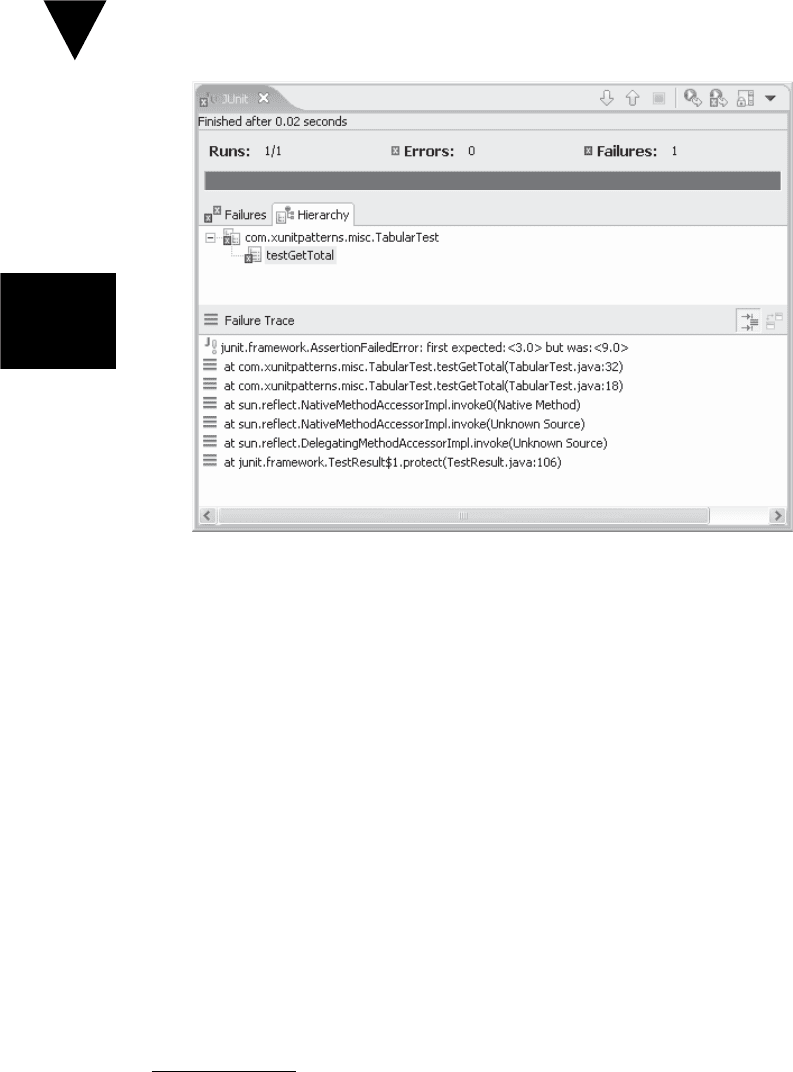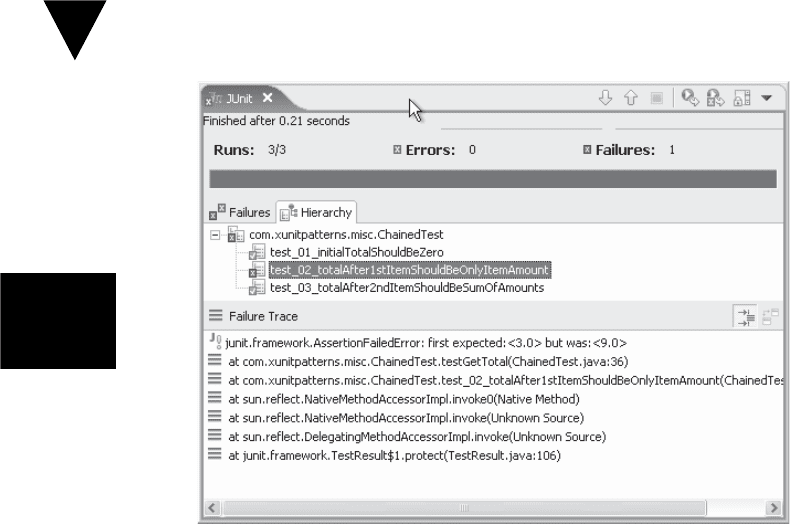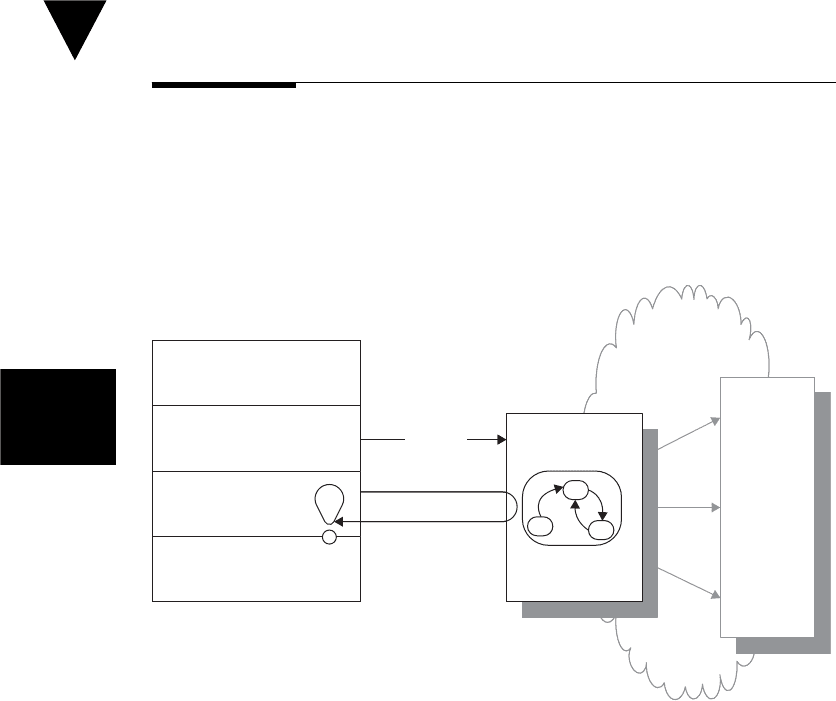Meszaros G. xUnit Test Patterns Refactoring Test Code
Подождите немного. Документ загружается.


458
Figure 20.3 Tabular Test results. The lower pane shows the details of the fi rst
failure inside the single Tabular Test method listed in the upper pane. Because of
the failure, the rest of the test method is not executed.
Refactoring Notes
We can convert this Tabular Test to a set of Chained Tests simply by breaking up
the single Test Method into one Test Method per subtest. One way to do so is to
use a series of Extract Method [Fowler] refactorings to create the Test Methods.
This will force us to use an Introduce Field [JetBrains] refactoring for any local
variables before the fi rst Extract Method refactoring operation. Once we have de-
fi ned all of the new Test Methods, we simply delete the original Test Method and
let the Test Automation Framework (page 298) call our new methods directly.
2
We need to ensure the tests run in the same order. Because JUnit seems to
sort the Testcase Objects by method name, we can force them into the right
order by including a sequence number in the Test Method name.
Finally, we need to convert our Fresh Fixture into a Shared Fixture. We do
so by changing our order fi eld (instance variable) into a class variable (a static
variable in Java) so that all of the Testcase Objects use the same Order.
2
If we don’t have a refactoring tool handy, no worries. Just end the Test Method after
each subtest and type in the signature of the next Test Method before the next subtest. We
then move any Shared Fixture variables out of the fi rst Test Method.
Chained
Tests
Chapter 20 Fixture Setup Patterns

459
Example: Chained Tests
Here’s the simple example turned into three separate tests:
private static Order order = new Order();
private static final double tolerance = 0.001;
public void test_01_initialTotalShouldBeZero() {
assertEquals("initial", 0.00, order.getTotal(), tolerance);
}
public void test_02_totalAfter1stItemShouldBeOnlyItemAmount(){
testAddItemAndGetTotal( "first", 1, 3.00, 3.00);
}
public void test_03_totalAfter2ndItemShouldBeSumOfAmounts() {
testAddItemAndGetTotal( "second",3, 5.00, 18.00);
}
private void testAddItemAndGetTotal( String msg,
int lineItemQuantity,
double lineItemPrice,
double expectedTotal) {
// create a line item
LineItem item =
new LineItem(lineItemQuantity, lineItemPrice);
// add line item to order
order.addItem(item);
// verify total
assertEquals(msg,expectedTotal,order.getTotal(),tolerance);
}
The Test Runner (page 377) gives us a better overview of what is wrong and
what is working (Figure 20.4).
Unfortunately, we will not be able to run any of the tests by themselves while
we debug this problem (except for the very fi rst test) because of the interdepen-
dencies between the tests; they are Lonely Tests.
Chained
Tests
Chained Tests

460
Figure 20.4 Chained Tests result. The upper pane shows the three test methods
with two tests passing. The lower pane shows the details of the one failing Test
Method.
Chained
Tests
Chapter 20 Fixture Setup Patterns

Chapter 21
Result Verifi cation Patterns
Patterns in This Chapter
Verifi cation Strategy
State Verifi cation . . . . . . . . . . . . . . . . . . . . . . . . . . . . . . . . . . . . 462
Behavior Verifi cation . . . . . . . . . . . . . . . . . . . . . . . . . . . . . . . . . 468
Assertion Method Styles
Custom Assertion . . . . . . . . . . . . . . . . . . . . . . . . . . . . . . . . . . . . 474
Delta Assertion. . . . . . . . . . . . . . . . . . . . . . . . . . . . . . . . . . . . . . 485
Guard Assertion . . . . . . . . . . . . . . . . . . . . . . . . . . . . . . . . . . . . . 490
Unfi nished Test Assertion . . . . . . . . . . . . . . . . . . . . . . . . . . . . . . 494
Result
Verifi cation
Patterns
461

462
Chapter 21 Result Verification Patterns
State Verifi cation
How do we make tests self-checking when there is state to be verifi ed?
We inspect the state of the system under test after it has been exercised and
compare it to the expected state.
A Self-Checking Test (see page 26) must verify that the expected outcome has
occurred without manual intervention by whoever is running the test. But what
do we mean by “expected outcome”? The SUT may or may not be “stateful”; if
it is stateful, it may or may not have a different state after it has been exercised.
As test automaters, it is our job to determine whether our expected outcome is a
change of fi nal state or whether we need to be more specifi c about what occurs
while the SUT is being exercised.
State Verifi cation involves inspecting the state of the SUT after it has been
exercised.
How It Works
We exercise the SUT by invoking the methods of interest. Then, as a separate
step, we interact with the SUT to retrieve its post-exercise state and compare it
with the expected end state by calling Assertion Methods (page 362).
Fixture
SUT
DOC
Exercise
Setup
Exercise
Verify
Teardown
Get State
A
C
B
Behavior
(Indirect
Outputs)
Fixture
SUT
DOC
Exercise
Setup
Exercise
Verify
Teardown
Get State
A
C
B
Behavior
(Indirect
Outputs)
Also known as:
State-Based
Testing
State
Verifi cation

463
Normally, we can access the state of the SUT simply by calling methods or
functions that return its state. This is especially true when we are doing test-driven
development because the tests will have ensured that the state is easily accessible.
When we are retrofi tting tests, however, we may fi nd it more challenging to access
the relevant state information. In these cases, we may need to use a Test-Specifi c
Subclass (page 579) or some other technique to expose the state without introduc-
ing Test Logic in Production (page 217).
A related question is “Where is the state of the SUT stored?” Sometimes, the
state is stored within the actual SUT; in other cases, the state may be stored in
another component such as a database. In the latter case, State Verifi cation may
involve accessing the state within the other component (essentially a layer-crossing
test). By contrast, Behavior Verifi cation (page 468) would involve verifying the
interactions between the SUT and the other component.
When to Use It
We should use State Verifi cation when we care about only the end state of the
SUT—not how the SUT got there. Taking such a limited view helps us maintain
encapsulation of the implementation of the SUT.
State Verifi cation comes naturally when we are building the software inside
out. That is, we build the innermost objects fi rst and then build the next layer
of objects on top of them. Of course, we may need to use Test Stubs (page 529)
to control the indirect inputs of the SUT to avoid Production Bugs (page 268)
caused by untested code paths. Even then, we are choosing not to verify the
indirect outputs of the SUT.
When we do care about the side effects of exercising the SUT that are not
visible in its end state (its indirect outputs), we can use Behavior Verifi cation to
observe the behavior directly. We must be careful, however, not to create Fragile
Tests (page 239) by overspecifying the software.
Implementation Notes
There are two basic styles of implementing State Verifi cation.
Variation: Procedural State Verifi cation
When doing Procedural State Verifi cation, we simply write a series of calls to
Assertion Methods that pick apart the state information into pieces and com-
pare those bits of information to individual expected values. Most people who
are new to automating tests take such a “path of least resistance.” The major
disadvantage of this approach is that it can result in Obscure Tests (page 186)
State Verification
State
Verifi cation

464
Chapter 21 Result Verification Patterns
owing to the number of assertions it may take to specify the expected outcome.
When the same sequence of assertions must be carried out in many tests or many
times within a single Test Method (page 348), we also have Test Code Duplica-
tion (page 213).
Variation: Expected State Specifi cation
When doing Expected State Specifi cation, we construct a specifi cation for the
post-exercise state of the SUT in the form of one or more objects populated with
the expected attributes. We then compare the actual state directly with these
objects using a single call to an Equality Assertion (see Assertion Method). This
tends to result in more concise and readable tests. We can use an Expected State
Specifi cation whenever we need to verify several attributes and it is possible to
construct an object that looks like the object we expect the SUT to return. The
more attributes we have that need to be compared and the more tests that need
to compare them, the more compelling the argument for using an Expected State
Specifi cation. In the most extreme cases, when we have a lot of data to verify, we
can construct an “expected table” and verify that the SUT contains it. Fit’s “row
fi xtures” offer a good way to do this in customer tests; tools such as DbUnit are
a good way to use Back Door Manipulation (page 327) for this purpose.
When constructing the Expected State Specifi cation, we may prefer to use
a Parameterized Creation Method (see Creation Method on page 415) so that
the reader is not distracted by all the necessary but unimportant attributes of
the Expected State Specifi cation. The Expected State Specifi cation is most often
an instance of the same class that we expect to get back from the SUT. We may
have diffi culty using an Expected State Specifi cation if the object doesn’t imple-
ment equality in a way that involves comparing the values of attributes (e.g., by
comparing the object references with each other) or if our test-specifi c defi nition
of equality differs from that implemented by the
equals method.
In these cases, we can still use an Expected State Specifi cation if we create
a Custom Assertion (page 474) that implements test-specifi c equality. Alterna-
tively, we can build the Expected State Specifi cation from a class that imple-
ments our test-specifi c equality. This class can either be a Test-Specifi c Subclass
that overrides the equals method or a simple Data Transfer Object [CJ2EEP] that
implements equals(TheRealObjectClass other). Both of these measures are preferable
to modifying (or introducing) the equals method on the production class, as that
would be a form of Equality Pollution (see Test Logic in Production). When
the class is diffi cult to instantiate, we can defi ne a Fake Object (page 551) that
has the necessary attributes plus an equals method that implements test-specifi c
equality. These last few “tricks” are made possible by the fact that Equality
State
Verifi cation
Also known as:
Expected
Object

465
Assertions usually ask the Expected State Specifi cation to compare itself to the
actual result, rather than the reverse.
We can build the Expected State Specifi cation either during the result verifi -
cation phase of the test immediately before it is used in the Equality Assertion
or during the fi xture setup phase of the test. The latter strategy allows us to use
attributes of the Expected State Specifi cation as parameters passed to the SUT
or as the base for Derived Values (page 718) when building other objects in the
test fi xture. This makes it easier to see the cause–effect relationship between
the fi xture and the Expected State Specifi cation, which in turn helps us achieve
Tests as Documentation (see page 23). It is particularly useful when the Ex-
pected State Specifi cation is created out of sight of the test reader such as when
using Creation Methods to do the construction.
Motivating Example
This simple
1
example features a test that exercises the code that adds a line item
to an invoice. Because it contains no assertions, it is not a Self-Checking Test.
public void testInvoice_addOneLineItem_quantity1() {
// Exercise
inv.addItemQuantity(product, QUANTITY);
}
We have chosen to create the invoice and product in the setUp method, an approach
called Implicit Setup (page 424).
public void setUp() {
product = createAnonProduct();
anotherProduct = createAnonProduct();
inv = createAnonInvoice();
}
Refactoring Notes
The fi rst refactoring we can do is not really a refactoring at all, because we are
changing the behavior of the tests (for the better): We introduce some assertions
that specify the expected outcome. This results in an example of Procedural
State Verifi cation because we make this change within the Test Method as a
series of calls to built-in Assertion Methods.
1
The natural example for this pattern is not very good at illustrating the difference
between State Verifi cation and Behavior Verifi cation. For this purpose, refer to Behavior
Verifi cation, which provides a second example of State Verifi cation that is more directly
comparable.
State Verification
State
Verifi cation

466
Chapter 21 Result Verification Patterns
We can further simplify the Test Method by refactoring it to use an Expected
Object. First, we build an Expected Object by constructing an object of the
expected class, or a suitable Test Double (page 522), and initializing it with
the values that were previously specifi ed in the assertions. Then we replace the
series of assertions with a single Equality Assertion that compares the actual
result with an Expected Object. We may have to use a Custom Assertion if we
need test-specifi c equality.
Example: Procedural State Verifi cation
Here we have added the assertions to the Test Method to turn it into a Self-
Checking Test. Because several steps must be carried out to verify the expected
outcome, this test suffers from a mild case of Obscure Test.
public void testInvoice_addOneLineItem_quantity1() {
// Exercise
inv.addItemQuantity(product, QUANTITY);
// Verify
List lineItems = inv.getLineItems();
assertEquals("number of items", lineItems.size(), 1);
// Verify only item
LineItem actual = (LineItem) lineItems.get(0);
assertEquals(inv, actual.getInv());
assertEquals(product, actual.getProd());
assertEquals(QUANTITY, actual.getQuantity());
}
Example: Expected Object
In this simplifi ed version of the test, we use the Expected Object with a single
Equality Assertion instead of a series of assertions on individual attributes:
public void testInvoice_addLineItem1() {
LineItem expItem = new LineItem(inv, product, QUANTITY);
// Exercise
inv.addItemQuantity( expItem.getProd(), expItem.getQuantity());
// Verify
List lineItems = inv.getLineItems();
assertEquals("number of items", lineItems.size(), 1);
LineItem actual = (LineItem) lineItems.get(0);
assertEquals("Item", expItem, actual);
}
State
Verifi cation

467
Because we are also using some of the attributes as arguments of the SUT, we
have chosen to build the Expected Object during the fi xture setup phase of the
test and to use the attributes of the Expected Object as the SUT arguments.
State Verification
State
Verifi cation
